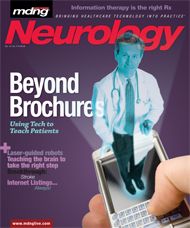Publication
Article
MDNG Neurology
Medical Robotics: Laser Guided Robot
Dr. Charlie Kemp, director of Georgia Tech's Center for Healthcare Robotics, discusses the laser-guided EL-E robot, which he created to help disabled patients pick up and manipulate objects.
Dr. Charlie Kemp, director of Georgia Tech’s Center for Healthcare Robotics, discusses the laser-guided EL-E robot, which he created to help disabled patients pick up and manipulate objects.
Why create a laser-guided robot?
I wanted to design robots that were going to meet real needs of people and advance the state of the art of robots. I wanted to build robots that can make a diff erence in healthcare, and in order to do that, they have to be able to perform useful tasks in any healthcare setting. It makes sense for robots to be able to pick up objects and move them to other places. It’s a level of capability that is needed in order to do a whole bunch of other things that we’d eventually like robots to do when they’re helping us.
Also of interest to me are assisted robotics: the robots that are going to help people with motor impairments. For example, for people with motor impairments given a task that we take for granted, like picking an object up off the fl oor, it ends up being a real problem—if it’s an important object, like the phone, it would lay on the ground until somebody comes and picks it up for them.
Once you decide that you’re going to help people acquire objects that are out of reach, there’s the question of how that person tells the robot what to do. Robotic technology is a long way from being able to help somebody communicate with the robot the way we communicate with each other. Th e laser pointer allows the user to very directly indicate an object to be retrieved. After I was already thinking about what to do with the laser pointer, some of the work with helper monkeys was really successful. Even quadriplegics were able to direct the helper monkeys by using the laser pointer to help them get objects or to perform other tasks. Th at sort of validated the whole idea. If it worked for people who are quadriplegics, and they’re able to use the interface easily with the helper monkeys, why can’t we do that with robots?
How did the idea become a reality?
I was in a post-doctoral position at MIT and was thinking about what we can do and how we can make robots helpful and perform useful tasks. I came to Georgia Tech, I had a preliminary proposal, and I got some internal funding to help move this endeavor forward. In collaboration with Professor Julie Jackos, who’s now at the University of Minnesota, and Dr. Jonathan Glass, director of the Emory ALS Center, we put together a grant and fortunately it was accepted, giving us money to take this project and make something happen with it. Th e collaboration has been great, because it’s been really valuable for my lab to interact with patients and to talk with Dr. Glass, whose expertise is in amyotrophic lateral sclerosis.
What are you hoping to achieve by testing the EL-E robot with patients who have ALS?
We’re hoping to validate the laser pointer as a useful interface. People with ALS have a number of motor impairments, and we want to make sure that it’s something that they could use for their various problems. We’re going to be testing how well the laser pointer interface actually works, and we’re going to also get their feedback on the robot itself and how it might help them, given the tasks that they’re using it for in the study. It’s in the laboratory setting, so it’s not going to be in their home yet. It’s an evolving, long-term research project that’s going to provide valuable information.
How do you intend to improve EL-E’s capabilities?
We’re working on a new version of the robot that will have the ability to carry heavier objects, giving the robot a broader set of tasks. Th ere’s still a lot we can do with the robot we have now. Although we’ve made signifi cant progress, we can make it more useful in someone’s cluttered home. Fundamental research needs to be done to make sure that this can really help someone in an everyday environment. It makes sense to start with this because so many other tasks that you might want the robot to help with in terms of activities of daily living would build on top of being able to go and get an object and be able to hand objects to people. It’s really just the start. My perspective is that people with ALS are model patients who exhibit lots of diff erent types of motor impairments. By working with them, we get a sense of what factors are important with many symptoms people might have. I feel that it’s important to take a group and work closely with them. Th e patients have been really supportive and are excited about the project, which helps a lot too. We believe in the potential for this robot to actually help a much larger group of people.






